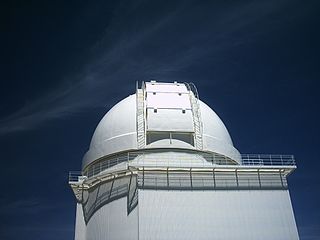The electromagnetic spectrum is the range of frequencies of electromagnetic radiation and their respective wavelengths and photon energies.

Observational astronomy is a division of astronomy that is concerned with recording data about the observable universe, in contrast with theoretical astronomy, which is mainly concerned with calculating the measurable implications of physical models. It is the practice and study of observing celestial objects with the use of telescopes and other astronomical instruments.

Jeffrey Alan Hoffman is an American former NASA astronaut and currently a professor of aeronautics and astronautics at MIT.
The Max Planck Institute for Extraterrestrial Physics is a Max Planck Institute, located in Garching, near Munich, Germany. In 1991 the Max Planck Institute for Physics and Astrophysics split up into the Max Planck Institute for Extraterrestrial Physics, the Max Planck Institute for Physics and the Max Planck Institute for Astrophysics. The Max Planck Institute for Extraterrestrial Physics was founded as sub-institute in 1963. The scientific activities of the institute are mostly devoted to astrophysics with telescopes orbiting in space. A large amount of the resources are spent for studying black holes in the galaxy and in the remote universe.

NASA's series of Great Observatories satellites are four large, powerful space-based astronomical telescopes launched between 1990 and 2003. They were built with different technology to examine specific wavelength/energy regions of the electromagnetic spectrum: gamma rays, X-rays, visible and ultraviolet light, and infrared light.

Jane X. Luu is a Vietnamese-American astronomer and defense systems engineer. She was awarded the Kavli Prize for 2012 "for discovering and characterizing the Kuiper Belt and its largest members, work that led to a major advance in the understanding of the history of our planetary system".

The Canada–France–Hawaii Telescope (CFHT) is located near the summit of Mauna Kea mountain on Hawaii's Big Island at an altitude of 4,204 meters, part of the Mauna Kea Observatory. Operational since 1979, the telescope is a Prime Focus/Cassegrain configuration with a usable aperture diameter of 3.58 metres (11.7 ft).

Robert Benjamin Leighton was a prominent American experimental physicist who spent his professional career at the California Institute of Technology (Caltech). His work over the years spanned solid state physics, cosmic ray physics, the beginnings of modern particle physics, solar physics, the planets, infrared astronomy, and millimeter- and submillimeter-wave astronomy. In the latter four fields, his pioneering work opened up entirely new areas of research that subsequently developed into vigorous scientific communities.

The NASA Infrared Telescope Facility is a 3-meter (9.8 ft) telescope optimized for use in infrared astronomy and located at the Mauna Kea Observatory in Hawaii. It was first built to support the Voyager missions and is now the US national facility for infrared astronomy, providing continued support to planetary, solar neighborhood, and deep space applications. The IRTF is operated by the University of Hawaii under a cooperative agreement with NASA. According to the IRTF's time allocation rules, at least 50% of the observing time is devoted to planetary science.

The Calar Alto Observatory is an astronomical observatory located in Almería province in Spain on Calar Alto, a 2,168-meter-high (7,113 ft) mountain in the Sierra de Los Filabres range.

A telescope is a device used to observe distant objects by their emission, absorption, or reflection of electromagnetic radiation. Originally it was an optical instrument using lenses, curved mirrors, or a combination of both to observe distant objects – an optical telescope. Nowadays, the word "telescope" is defined as wide range of instruments capable of detecting different regions of the electromagnetic spectrum, and in some cases other types of detectors.
Herbert Gursky was the Superintendent of the Naval Research Laboratory's Space Science Division and Chief Scientist of the E.O. Hulburt Center for Space Research.

The Small Astronomy Satellite 3 was a NASA X-ray astronomy space telescope. It functioned from May 7, 1975 to April 1979. It covered the X-ray range with four experiments on board. The satellite, built by the Johns Hopkins University Applied Physics Laboratory (APL), was proposed and operated by MIT's Center for Space Research (CSR). It was launched on a Scout vehicle from the Italian San Marco launch platform near Mombasa, Kenya, into a low-Earth, nearly equatorial orbit. It was also known as Explorer 53, as part of NASA's Explorer program.

Integral field spectrographs (IFS) combine spectrographic and imaging capabilities in the optical or infrared wavelength domains (0.32 μm – 24 μm) to get from a single exposure spatially resolved spectra in a bi-dimensional region. The name originates from the fact that the mesurements result from integrating the light on multiple sub-regions of the field. Developed at first for the study of astronomical objects, this technique is now also used in many other fields, such bio-medical science and Earth remote sensing. Integral field spectrography is part of the broader category of snapshot hyperspectral imaging techniques, itself a part of hyperspectral imaging.
James Richard Houck was the Kenneth A. Wallace Professor of Astronomy at Cornell University.
Ian Stewart Glass is an infrared astronomer and scientific historian living in Cape Town, South Africa.
Lynne Karen Deutsch was an American astrophysicist who helped develop the Smithsonian Astrophysical Observatory/University of Arizona Mid-Infrared Array Camera (MIRAC). Deutsch was born in Chicago and earned her MS from MIT in 1983 and Ph. D. from Harvard in 1990. Her dissertation was on grain processing and the evolution of planetary nebulae with a mid-infrared array camera. Between 1990 and 1992 Deutsch served as a Post-doctoral Fellow at the NASA Ames Research Center where she worked on MIRAC.
Giovanni Fazio is an American physicist at Center for Astrophysics | Harvard & Smithsonian. He is an astrophysicist who has initiated and participated in multiple observation programs.










